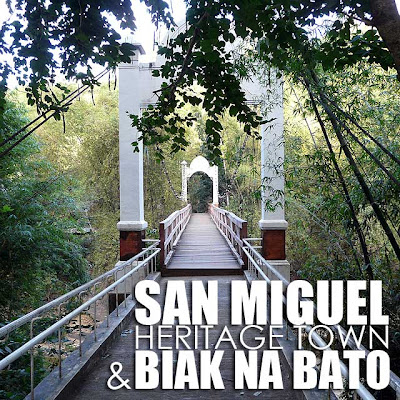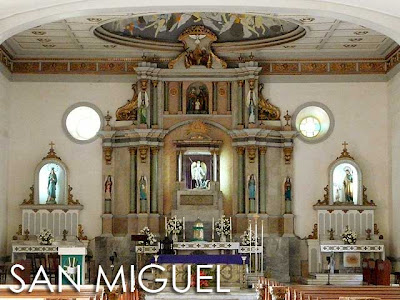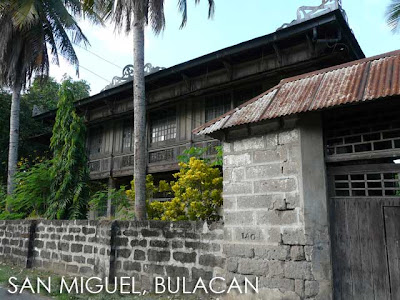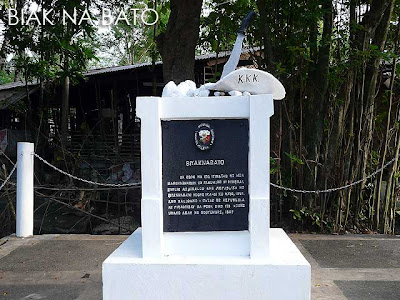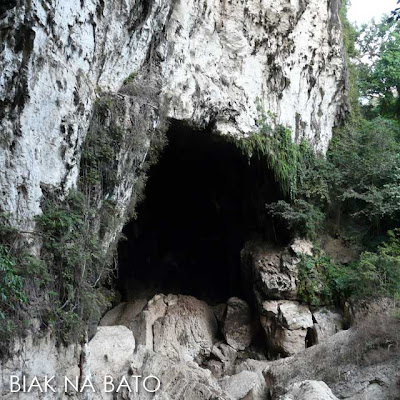There is no doubt that Vigan, Ilocos Sur is the best preserved colonial town in the Philippines. But for those in Metro Manila who just want to make a day-trip to a nearby heritage town, here are twelve places you might want to visit.
1. Taal, Batangas
Taal (the town, not the volcano) is the best preserved Spanish colonial town near Manila. People might be thinking Tagaytay City because of its view of Taal Volcano, but the town is actually 42 kilometers away. The historic town center of Taal was declared a National Historical Landmark. Dozens of Spanish colonial homes, several historical landmarks, the Taal Municipal Hall, Santa Lucia Well, and two centuries-old churches — the Taal Basilica and Caysasay Shrine — are among the highlights of a visit to Taal.
The town has several museums including the homes of Marcela Agoncillo, Felipe Agoncillo, Leon Apacible and Gliceria Villavicencio and the Galleria Taal. Don't forget to visit the local market where you can buy good quality piña and other embroidered cloths for barongs and Filipiniana dresses. Popular dishes from Taal are longganisa, tapa, adobo sa dilaw, empanada, panutsa, suman,tawilis (tawilis is now an endangered species, don't eat it) and tulingan. The balisong, a pocket knife which is also known as the butterfly knife, is also from Taal.
It's easy to do a day-trip to Taal. For those with vehicles, exit the STAR Tollway at Lipa (Taal town is about 32 kilometers from the exit). Please check this map for directions. By public transportation, take a bus to Lemery, Batangas and a then a jeep or tricycle to Taal. After exploring Taal, you can opt to have dinner in Tagaytay City, proceeding there via Lemery and Diokno Highway. But be prepared for the traffic snarls in Tagaytay. There are also several old houses which offer overnight accommodation such as Casa Severina and Villa Tortuga. Here's more information on Taal.
1. Taal, Batangas
Taal (the town, not the volcano) is the best preserved Spanish colonial town near Manila. People might be thinking Tagaytay City because of its view of Taal Volcano, but the town is actually 42 kilometers away. The historic town center of Taal was declared a National Historical Landmark. Dozens of Spanish colonial homes, several historical landmarks, the Taal Municipal Hall, Santa Lucia Well, and two centuries-old churches — the Taal Basilica and Caysasay Shrine — are among the highlights of a visit to Taal.
The town has several museums including the homes of Marcela Agoncillo, Felipe Agoncillo, Leon Apacible and Gliceria Villavicencio and the Galleria Taal. Don't forget to visit the local market where you can buy good quality piña and other embroidered cloths for barongs and Filipiniana dresses. Popular dishes from Taal are longganisa, tapa, adobo sa dilaw, empanada, panutsa, suman,
It's easy to do a day-trip to Taal. For those with vehicles, exit the STAR Tollway at Lipa (Taal town is about 32 kilometers from the exit). Please check this map for directions. By public transportation, take a bus to Lemery, Batangas and a then a jeep or tricycle to Taal. After exploring Taal, you can opt to have dinner in Tagaytay City, proceeding there via Lemery and Diokno Highway. But be prepared for the traffic snarls in Tagaytay. There are also several old houses which offer overnight accommodation such as Casa Severina and Villa Tortuga. Here's more information on Taal.
Another National Historical Landmark close to Manila is Pila, Laguna. This heritage town is a beautiful collection of colonial homes surrounding a green plaza with the Pila Municipal Hall at one end and the Pila Church on the opposite end. Walking around the plaza is like entering a time machine since the historic fabric of the town is relatively intact.
Even beyond the plaza are fantastic examples of Filipino homes built during the Spanish and American colonial periods. So if you're on your way to Santa Cruz, Pagsanjan or beyond, make sure to include Pila in your itinerary. Any bus to Santa Cruz, Laguna will pass through Pila.
Even beyond the plaza are fantastic examples of Filipino homes built during the Spanish and American colonial periods. So if you're on your way to Santa Cruz, Pagsanjan or beyond, make sure to include Pila in your itinerary. Any bus to Santa Cruz, Laguna will pass through Pila.
3. Balayan, Batangas
Balayan is another Batangas town that is rich in heritage. The Balayan Church is a National Cultural Treasure. And many of its old ancestral homes are still intact.
I heard the locals are planning a heritage tourism program. But for now, the homes are not open to the public though. Walking around the town will definitely make an interesting historical tour. You might want to pass by Balayan especially on the way to the neighboring town of Calatagan. And just further down the road is Calaca, which has a nice Spanish colonial church and several ancestral houses.
4. Sariaya, Quezon
Further down south is Sariaya, Quezon. It has a fabulous Art Deco municipal hall and three of its many ancestral mansions are declared heritage houses — Natalio Enriquez House, Rodriguez House and Gala-Rodriguez House. The Sariaya Church is also quite interesting with convent buildings on both sides. Too bad though the local government built a multi-purpose hall on one side of what would have been a classic example of a colonial plaza.
The best time to visit Sariaya is on May 15 when the town celebrates the feast of San Isidro Labrador. The ancestral houses are also opened for a fee. But you'll have to deal with the crowds who a troop to Quezon for the many colorful celebrations on that day. Any bus to Lucena, Quezon passes through Sariaya.
5. San Juan, Batangas
San Juan, Batangas is another town with many Art Deco mansions. Few people pass through the town's historic center on the way to Laiya Beach not realizing its hidden treasure. None of the houses in San Juan have been declared. Hopefully the local government has the vision to create a heritage tourism program that will complement Laiya Beach.
6. San Fernando, Pampanga
San Fernando is known for many things — the Giant Lantern Festival, San Pedro Cutud Lenten Rites, and great Kapampangan food among others! It also has managed to preserve a small historic quarter in the downtown area. Five houses have been declared heritage houses — Lazatin House, Hizon-Singian House, Henson-Hizon House, Dayrit House and Augusto P. Hizon House. The San Fernando Train Station, where Rizal got off during his trip to invite friends to the La Liga Filipina and where the long walk of the Bataan Death March ended, still stands.
The San Fernando Cathedral and Pampanga Provincial Capitol can also be found in the heritage district. What excites me is the prospect of revitalizing the PASUDECO Sugar Central for conversion into a shopping and entertainment complex. My fingers are crossed.
San Fernando must be the only city in the Philippines where motorized tricycles are not allowed in the downtown area. Instead, the historic center still has many kalesas (horse-drawn carriages) which can take you for a tour around the city. Here is more information on San Fernando.
After you tour, make sure to have breakfast, lunch or merienda in the many restaurants in the city (Everybody's Cafe is an institution) that serve authentic Kapampangan cuisine. You can also visit the nearby Bacolor Church and Betis Church, a National Cultural Treasure. Too bad Bacolor's ancestral mansions were covered by lahar. Pampanga lost a heritage treasure!
Further down south is Sariaya, Quezon. It has a fabulous Art Deco municipal hall and three of its many ancestral mansions are declared heritage houses — Natalio Enriquez House, Rodriguez House and Gala-Rodriguez House. The Sariaya Church is also quite interesting with convent buildings on both sides. Too bad though the local government built a multi-purpose hall on one side of what would have been a classic example of a colonial plaza.
The best time to visit Sariaya is on May 15 when the town celebrates the feast of San Isidro Labrador. The ancestral houses are also opened for a fee. But you'll have to deal with the crowds who a troop to Quezon for the many colorful celebrations on that day. Any bus to Lucena, Quezon passes through Sariaya.
5. San Juan, Batangas
San Juan, Batangas is another town with many Art Deco mansions. Few people pass through the town's historic center on the way to Laiya Beach not realizing its hidden treasure. None of the houses in San Juan have been declared. Hopefully the local government has the vision to create a heritage tourism program that will complement Laiya Beach.
6. San Fernando, Pampanga
San Fernando is known for many things — the Giant Lantern Festival, San Pedro Cutud Lenten Rites, and great Kapampangan food among others! It also has managed to preserve a small historic quarter in the downtown area. Five houses have been declared heritage houses — Lazatin House, Hizon-Singian House, Henson-Hizon House, Dayrit House and Augusto P. Hizon House. The San Fernando Train Station, where Rizal got off during his trip to invite friends to the La Liga Filipina and where the long walk of the Bataan Death March ended, still stands.
The San Fernando Cathedral and Pampanga Provincial Capitol can also be found in the heritage district. What excites me is the prospect of revitalizing the PASUDECO Sugar Central for conversion into a shopping and entertainment complex. My fingers are crossed.
San Fernando must be the only city in the Philippines where motorized tricycles are not allowed in the downtown area. Instead, the historic center still has many kalesas (horse-drawn carriages) which can take you for a tour around the city. Here is more information on San Fernando.
After you tour, make sure to have breakfast, lunch or merienda in the many restaurants in the city (Everybody's Cafe is an institution) that serve authentic Kapampangan cuisine. You can also visit the nearby Bacolor Church and Betis Church, a National Cultural Treasure. Too bad Bacolor's ancestral mansions were covered by lahar. Pampanga lost a heritage treasure!
7. Malolos, Bulacan
Malolos was a revolutionary capital of the Philippines. The Barasoain Church, home of the Malolos Congress, has always been featured on Philippine currency. The city's historic center was declared a National Historical Landmark especially since many of the houses served as offices of the Philippine Revolutionary Government.
Too bad though that many of the owners don't seem to understand the historical value of their homes. And quite a number have been dismantled by eager antique dealers, despite being declared. So visit Malolos while it's still there, and before antique dealers beat us to it. This city would have made such an interesting heritage walk!
Malolos was a revolutionary capital of the Philippines. The Barasoain Church, home of the Malolos Congress, has always been featured on Philippine currency. The city's historic center was declared a National Historical Landmark especially since many of the houses served as offices of the Philippine Revolutionary Government.
Too bad though that many of the owners don't seem to understand the historical value of their homes. And quite a number have been dismantled by eager antique dealers, despite being declared. So visit Malolos while it's still there, and before antique dealers beat us to it. This city would have made such an interesting heritage walk!
8. Kawit, Cavite
The birthplace of the Republic of the Philippines, Kawit has three major heritage sites — Emilio Aguinaldo Shrine (where the declaration of Philippine independence was made on June 12, 1898), Baldomero Aguinaldo Shrine and the Kawit Church. Aside from those three important sites, there's nothing much to see in Kawit. But most people stop by Kawit as part of any Cavite historical tour or day-trip which goes all the way to Maragondon.
The birthplace of the Republic of the Philippines, Kawit has three major heritage sites — Emilio Aguinaldo Shrine (where the declaration of Philippine independence was made on June 12, 1898), Baldomero Aguinaldo Shrine and the Kawit Church. Aside from those three important sites, there's nothing much to see in Kawit. But most people stop by Kawit as part of any Cavite historical tour or day-trip which goes all the way to Maragondon.
9. Maragondon, Cavite
Another town on the Cavite historical trail, Maragondon has three important sites — Maragondon Church, Bonifacio Trial House and the Execution Site of Andres Bonifacio. The Maragondon Church is a National Cultural Treasure. While the Bonifacio Trial House is a National Historical Landmark. Here is more information on Maragondon.
Another town on the Cavite historical trail, Maragondon has three important sites — Maragondon Church, Bonifacio Trial House and the Execution Site of Andres Bonifacio. The Maragondon Church is a National Cultural Treasure. While the Bonifacio Trial House is a National Historical Landmark. Here is more information on Maragondon.
San Miguel is a charming old town with beautiful ancestral mansions. But the charm is fast disappearing because the local government of San Miguel, Bulacan has not really done anything to ensure the protection of the local heritage.
Part of the Biak na Bato National Park is also in San Miguel. Ironically, despite the large number of ancestral houses, none of them are declared. So just like Malolos, better visit San Miguel before the heritage disappears.
Part of the Biak na Bato National Park is also in San Miguel. Ironically, despite the large number of ancestral houses, none of them are declared. So just like Malolos, better visit San Miguel before the heritage disappears.
11. Biñan, Laguna
We've all heard the battle cry "Save the Alberto House!" The historic home of Teodora Alonso's family is still in Biñan, or what's left of it. I was pleasantly surprised to see so many Spanish colonial houses in Biñan. In fact, some of them still have clay tile roofs. The only things that need to be addressed are cleanliness and order in the heritage street which is very close to the market. Biñan actually has much potential as a heritage destination. Hopefully the heritage quarter is declared and revitalized by the local government.
12. Malabon, Metro Manila
Okay, so Malabon is part of Metro Manila! But it's at the edge and I just had to include it in this list. Most people don't realize that Malabon, as well as Navotas, used to be a separate islands until shortsighted reclamation projects fused it with the rest of Luzon. And we wonder why the area floods? Back to the heritage, Malabon has a fantastic collection of heritage houses. I wonder if the local government even realizes the potential for tourism. There are occasional cultural tours to Malabon, maybe once a year. But on a regular day, you'll have to explore on your own. While you are there, try out the pansit, sapin-sapin, kikiam, sumpia and broas!
Other interesting heritage towns near Metro Manila are (13) Tayabas (Tayabas Basilica, Malagonlong Bridge and several other bridges are National Cultural Treasures) and (14) Lucban in Quezon, (15) Angeles City (Angeles Church, Pamintuan Mansion, Museo ning Angeles and Center for Kapampangan Studies) and (16) Santa Rita in Pampanga, (17) Paete (Paete Church), (18) Pakil (Pakil Church) and (19) Pagsanjan in Laguna, and (20) Bustos in Bulacan. Did I miss out any heritage town near Manila?
We've all heard the battle cry "Save the Alberto House!" The historic home of Teodora Alonso's family is still in Biñan, or what's left of it. I was pleasantly surprised to see so many Spanish colonial houses in Biñan. In fact, some of them still have clay tile roofs. The only things that need to be addressed are cleanliness and order in the heritage street which is very close to the market. Biñan actually has much potential as a heritage destination. Hopefully the heritage quarter is declared and revitalized by the local government.
12. Malabon, Metro Manila
Okay, so Malabon is part of Metro Manila! But it's at the edge and I just had to include it in this list. Most people don't realize that Malabon, as well as Navotas, used to be a separate islands until shortsighted reclamation projects fused it with the rest of Luzon. And we wonder why the area floods? Back to the heritage, Malabon has a fantastic collection of heritage houses. I wonder if the local government even realizes the potential for tourism. There are occasional cultural tours to Malabon, maybe once a year. But on a regular day, you'll have to explore on your own. While you are there, try out the pansit, sapin-sapin, kikiam, sumpia and broas!
Other interesting heritage towns near Metro Manila are (13) Tayabas (Tayabas Basilica, Malagonlong Bridge and several other bridges are National Cultural Treasures) and (14) Lucban in Quezon, (15) Angeles City (Angeles Church, Pamintuan Mansion, Museo ning Angeles and Center for Kapampangan Studies) and (16) Santa Rita in Pampanga, (17) Paete (Paete Church), (18) Pakil (Pakil Church) and (19) Pagsanjan in Laguna, and (20) Bustos in Bulacan. Did I miss out any heritage town near Manila?

























